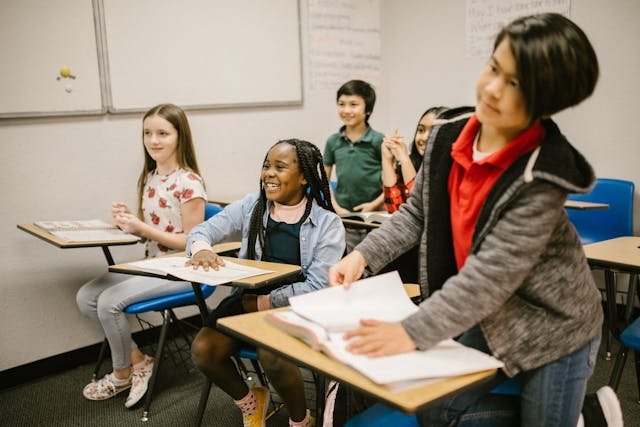Schooling is a basic human proper but the standard of schooling just isn’t equally distributed. Many college students, notably these from marginalized backgrounds, expertise obstacles to studying that have an effect on their tutorial outcomes and private progress. To handle this difficulty, creating an inclusive and equitable classroom is essential. Inclusive schooling ensures that every one college students no matter their background talents or socioeconomic standing have equal alternatives to succeed. Selling equity in schooling requires deliberate and strategic efforts by academics, faculties coverage makers and communities. On this article we are going to discover the steps essential to create an inclusive and equitable classroom.

1. Understanding Inclusive and Equitable Schooling
To start it is very important differentiate between inclusivity and fairness in schooling.
- Inclusivity refers to making a studying atmosphere the place all college students together with these with disabilities of various cultural backgrounds and ranging studying talents really feel valued, revered and supported.
- Fairness then again goes past equality. It acknowledges that some college students face extra vital challenges than others on account of historic social and financial disadvantages. Fairness entails offering the suitable assets and help that particular person college students have to succeed fairly than giving everybody the identical degree of assets (which assumes all college students begin from the identical place).
Each ideas are interlinked as inclusivity ensures that no pupil is excluded from the training course of whereas fairness ensures that every pupil has what they should thrive.
2. The Significance of Selling Honest Schooling
Selling honest schooling has a far reaching affect not solely on particular person college students however on society as an entire. Some key advantages of fostering an inclusive and equitable classroom embrace:
- Improved tutorial efficiency: When college students really feel valued and supported they’re extra more likely to interact actively of their studying main to raised tutorial outcomes.
- Social cohesion: An inclusive classroom promotes understanding and respect for variety. This helps college students develop empathy tolerance and collaboration expertise that are crucial in a multicultural society.
- Decreased achievement gaps: Equitable schooling works to shut the hole between advantaged and deprived college students offering every youngster with an equal alternative to attain their full potential.
- Private progress and wellbeing: A good classroom helps college students construct confidence and a constructive sense of self price each of that are important for his or her psychological well being and emotional growth.
3. Challenges to Inclusivity and Fairness in Schooling
Regardless of widespread settlement on the significance of honest schooling there are quite a few obstacles to creating inclusive and equitable lecture rooms:
- Cultural biases: Colleges might unintentionally favor sure cultural norms or language practices that alienate college students from totally different ethnic or linguistic backgrounds.
- Socioeconomic disparities: College students from low revenue households might lack entry to assets equivalent to expertise books or tutoring placing them at a drawback in comparison with wealthier friends.
- Disabilities and studying variations: College students with bodily or cognitive disabilities usually face obstacles to studying in lecture rooms that aren’t designed to accommodate their wants. They might lack applicable help together with assistive applied sciences or modified curricula.
- Instructor preparedness: Not all academics have obtained the mandatory coaching to implement inclusive practices or to handle the varied wants of their college students successfully.
4. Key Steps Towards an Inclusive and Equitable Classroom
Addressing these challenges requires focused actions at a number of ranges. Beneath are a number of steps that educators and policymakers can take to advertise a good and inclusive studying atmosphere.
4.1. Culturally Responsive Instructing
Culturally responsive educating (CRT) is an educational method that acknowledges the significance of together with college students’ cultural references in all points of studying. It encourages educators to:
- Perceive and worth variety: Academics ought to study in regards to the cultures and backgrounds of their college students to raised perceive their views and studying wants. This could contain integrating multicultural content material into the curriculum celebrating cultural occasions or inviting numerous visitor audio system.
- Adapt educating strategies: Conventional educating strategies might not resonate with all college students. Academics ought to adapt their strategies to mirror college students’ numerous studying types and cultural backgrounds. For instance a instructor might use tales, examples of drawback fixing methods which might be related to totally different cultural contexts.
- Create an inclusive classroom tradition: Academics ought to encourage open dialogue about variety and foster an atmosphere the place all college students really feel revered and included. Establishing clear norms round mutual respect and open mindedness can assist create a constructive classroom environment.
4.2. Differentiated Instruction
Differentiated instruction is the observe of tailoring educating methods to fulfill the varied wants of scholars. It’s particularly essential in lecture rooms with college students of various talents and studying preferences. Key parts of differentiated instruction embrace:
- Versatile grouping: Group college students based mostly on their talents or studying preferences for particular duties permitting them to work at a tempo that fits their wants. These teams will be fluid altering over time as college students’ expertise develop.
- Selection in educating supplies: Present a number of methods for college students to interact with content material equivalent to movies, interactive actions or palms on studying along with conventional studying and lectures. This helps cater to totally different studying types together with auditory visible and kinesthetic learners.
- Individualized studying plans: The place possible, create personalised studying objectives for college students notably these with particular wants. This ensures that every pupil has a transparent path to success with milestones which might be tailor-made to their talents.
4.3. Common Design for Studying (UDL)
Common Design for Studying (UDL) is an academic framework that goals to create studying environments that accommodate all college students together with these with disabilities. UDL promotes flexibility in educating by providing college students a number of methods to entry info, exhibit their information and keep engaged. The three core ideas of UDL are:
- A number of technique of illustration: Present info in several codecs (e.g. textual content audio visible interactive) to accommodate numerous studying preferences.
- A number of technique of motion and expression: Enable college students to exhibit their information in several methods equivalent to by way of written assignments oral shows or artistic tasks.
- A number of technique of engagement: Inspire college students by providing decisions in how they study and inspiring them to take possession of their studying course of.
- By adopting UDL ideas educators can create lecture rooms which might be extra accessible to college students with a variety of talents and desires.
4.4. Addressing Socio Financial Inequities
To create an equitable classroom academics should acknowledge the affect of socioeconomic disparities on studying and take steps to mitigate these results. Methods embrace:
- Offering entry to assets: Colleges ought to be sure that all college students have entry to the instruments they want for studying equivalent to textbooks, computer systems or web entry. This would possibly contain creating mortgage packages for expertise or providing free tutoring companies for college students who want additional help.
- Supporting fundamental wants: College students who come to high school hungry or with out ample clothes might wrestle to concentrate on their research. Colleges can companion with group organizations to supply meals clothes and different important companies to college students in want.
- Constructing relationships with households: Academics ought to interact with the households of scholars from low revenue backgrounds providing help and assets to assist them navigate the tutorial system. This would possibly contain holding workshops on easy methods to help kids’s studying at dwelling or offering details about native companies that may help with meals housing or well being care.
4.5. Fostering a Development Mindset
A progress mindset developed by psychologist Carol Dweckis the idea that intelligence and skills will be developed by way of effort and studying. Encouraging a progress mindset within the classroom promotes fairness as a result of it emphasizes the potential of all college students no matter their start line. Academics can foster a progress mindset by:
- Praising effort not simply outcomes: Acknowledge college students for the laborious work they put into their studying fairly than solely specializing in grades or take a look at scores. This encourages college students to take dangers and think about challenges as alternatives for progress.
- Normalizing errors: Create a classroom tradition the place making errors is seen as a pure a part of the training course of. This may be performed by overtly discussing errors and modeling easy methods to study from them.
- Offering alternatives for reflection: Encourage college students to mirror on their progress and determine areas the place they will enhance. Reflection helps college students take possession of their studying journey and construct resilience.
4.6. Skilled Improvement for Academics
Ongoing skilled growth is essential for academics to remain knowledgeable about greatest practices in inclusive and equitable schooling. Coaching packages ought to concentrate on:
- Cultural competence: Educators want to pay attention to the cultural dynamics of their lecture rooms and the way these affect studying. Coaching ought to cowl matters equivalent to implicit bias antiracist educating practices and methods for creating culturally responsive curriculum.
- Inclusive educating strategies: Academics ought to be educated in methods like differentiated instruction UDL and methods for supporting college students with disabilities. This ensures that they’ve the instruments they should meet the varied wants of their college students.
- Trauma Knowledgeable educating: Many college students notably these from marginalized backgrounds might have skilled trauma that impacts their capability to study. Academics ought to be geared up with methods for making a secure supportive classroom atmosphere that promotes therapeutic and studying.
4.7. Constructing Inclusive Insurance policies and Practices
Along with classroom degree modifications faculty vast insurance policies play a crucial position in selling fairness. These would possibly embrace:
- Anti Discrimination insurance policies: Colleges ought to have clear insurance policies in place to stop discrimination based mostly on race, gender capability or socioeconomic standing. This contains mechanisms for reporting and addressing discriminatory habits amongst college students or workers.
- Equitable useful resource allocation: Colleges should be sure that assets equivalent to funding expertise or specialised workers are distributed based mostly on the wants of scholars fairly than being equally divided throughout all lecture rooms.
- Inclusive curricula: Colleges ought to be sure that curricula mirror numerous views and experiences. This helps all college students see themselves represented in what they’re
studying and fosters a deeper understanding of the world round them.
Conclusion
Selling honest schooling is not only an ethical crucial; it’s important for constructing a extra simply and equitable society. Creating an inclusive and equitable classroom requires educators to be proactive, versatile and conscious of the varied wants of their college students. By embracing methods like culturally responsive educating differentiated instruction Common Design for Studying and fostering a progress mindset educators can be sure that all college students have the chance to succeed.
Reaching instructional fairness additionally requires systemic modifications on the faculty and coverage ranges together with equitable useful resource distribution and antidiscriminatory practices. By taking these steps we are able to transfer nearer to a future the place each pupil has entry to a highquality schooling no matter their background or circumstances.
FAQs
1: What’s the distinction between inclusivity and fairness in schooling?
Inclusivity refers to making a studying atmosphere the place all college students no matter their backgrounds or talents really feel valued and supported. Fairness then again acknowledges that some college students face better challenges on account of historic or socioeconomic components and focuses on offering the precise assets and help every particular person must succeed.
2: Why is selling honest schooling essential?
Selling honest schooling is important as a result of it results in improved tutorial efficiency, social cohesion, lowered achievement gaps and enhanced private progress for college students. A good schooling system helps be sure that all college students have equal alternatives to succeed and thrive of their instructional journeys.
3: What are some widespread challenges to creating an inclusive classroom?
Widespread challenges embrace cultural biases, socioeconomic disparities, disabilities and studying variations and an absence of instructor preparedness to handle numerous wants. These obstacles can hinder the power of some college students to entry high quality schooling and have interaction totally within the studying course of.
4: How can academics implement culturally responsive educating?
Academics can implement culturally responsive educating by understanding and valuing their college students’ cultural backgrounds, adapting educating strategies to mirror numerous views, integrating multicultural content material into the curriculum and fostering an inclusive classroom tradition that encourages open dialogue about variety.
5: What’s Common Design for Studying (UDL) and the way does it profit college students?
Common Design for Studying (UDL) is an academic framework that promotes versatile educating strategies to accommodate all college students together with these with disabilities. UDL advantages college students by offering a number of technique of illustration, motion expression and engagement guaranteeing that everybody can entry the curriculum and exhibit their information in ways in which go well with their particular person wants.
6: How can faculties deal with socioeconomic inequities in schooling?
Colleges can deal with socioeconomic inequities by offering entry to important assets (like expertise and tutoring) supporting college students’ fundamental wants (equivalent to meals and clothes) and constructing relationships with households to assist them navigate the tutorial system and entry obtainable assets.
7: What position does skilled growth play in selling honest schooling?
Ongoing skilled growth is crucial for academics to remain knowledgeable about greatest practices in inclusive and equitable schooling. Coaching in cultural competence inclusive educating strategies and trauma knowledgeable practices equips educators with the instruments they should deal with the varied wants of their college students successfully.

